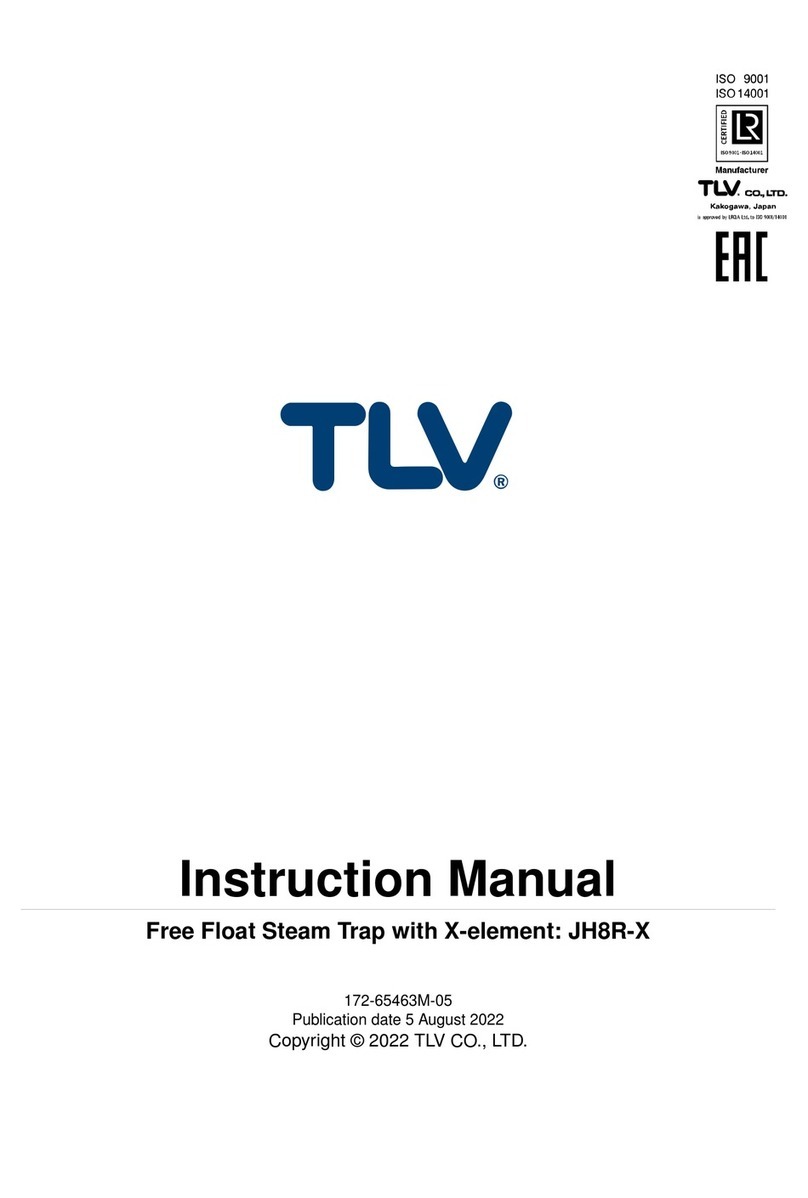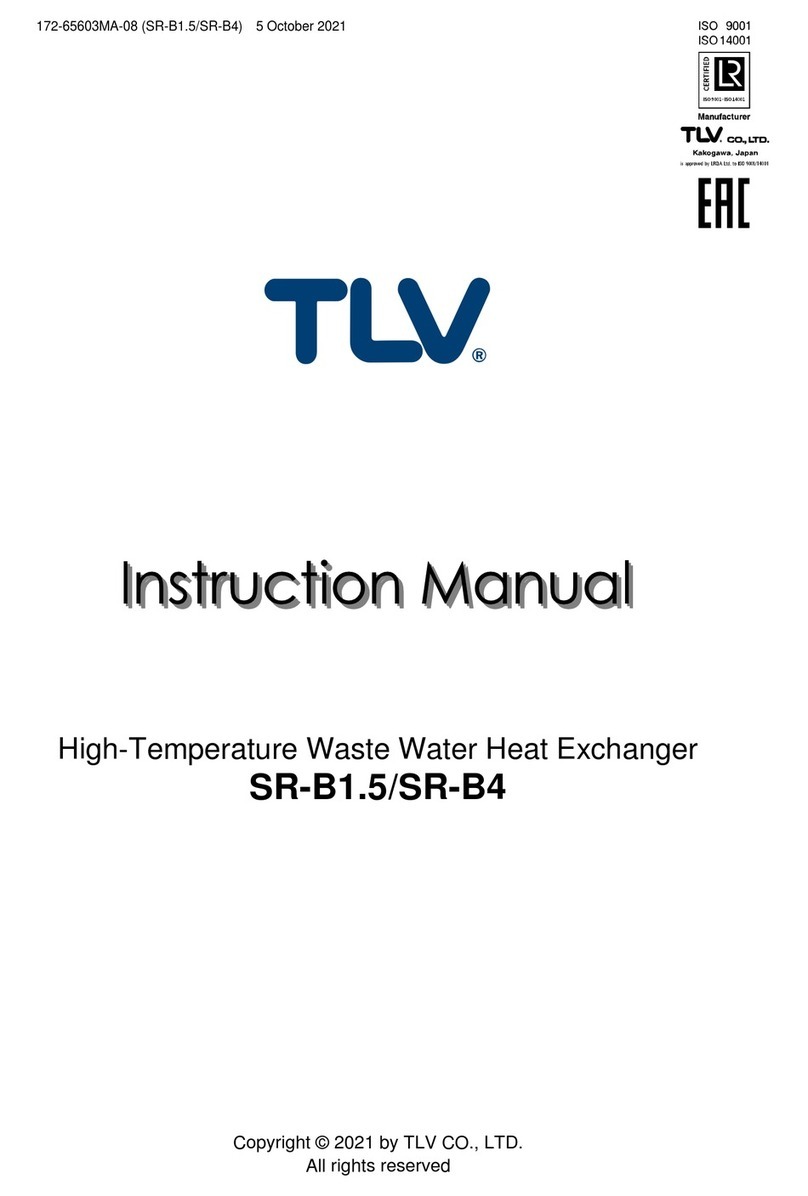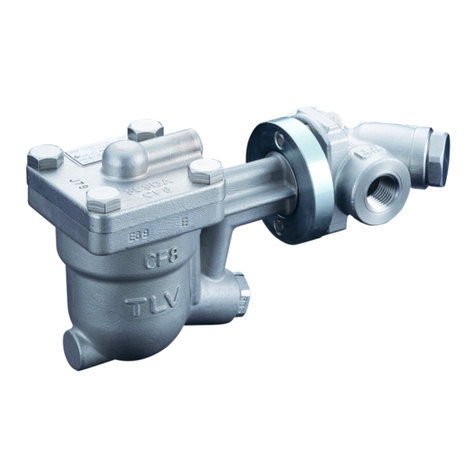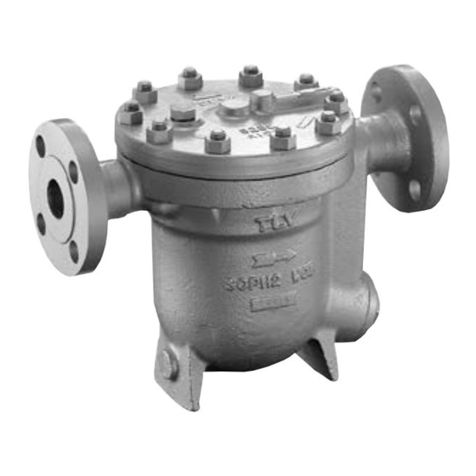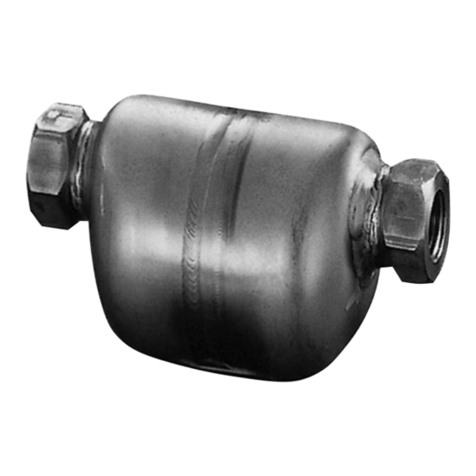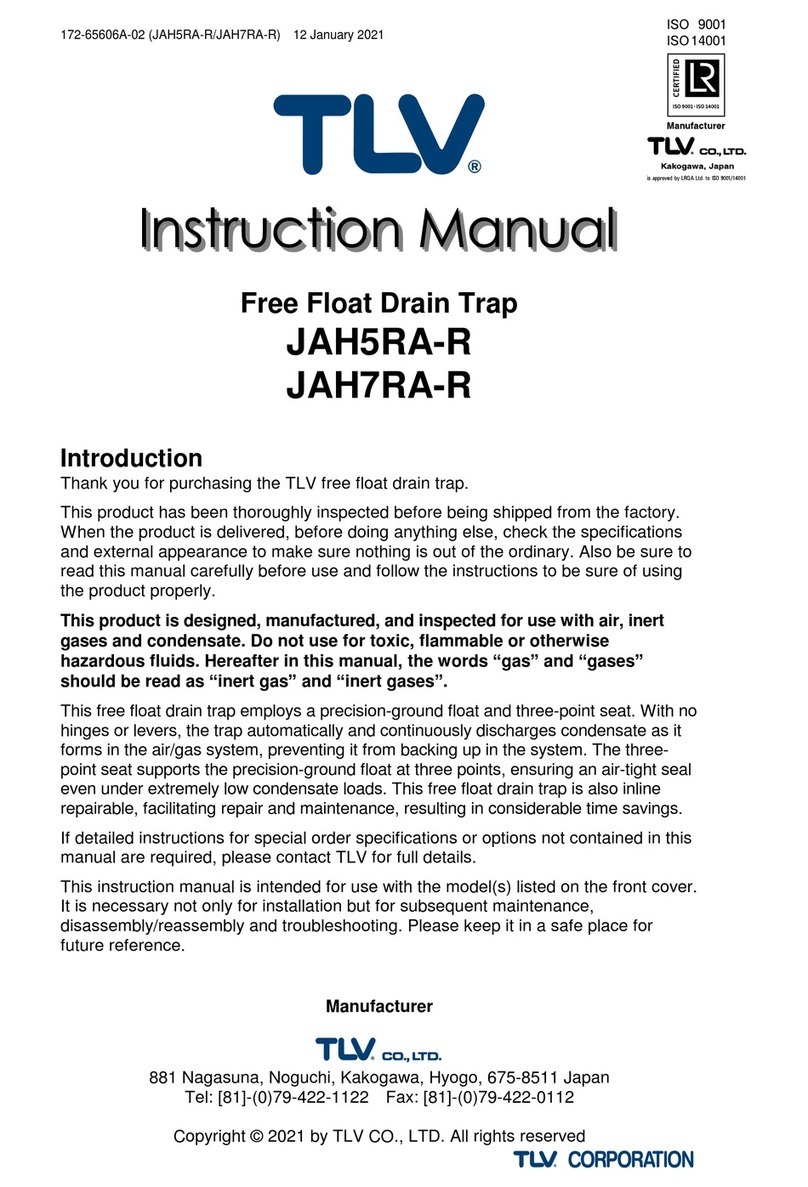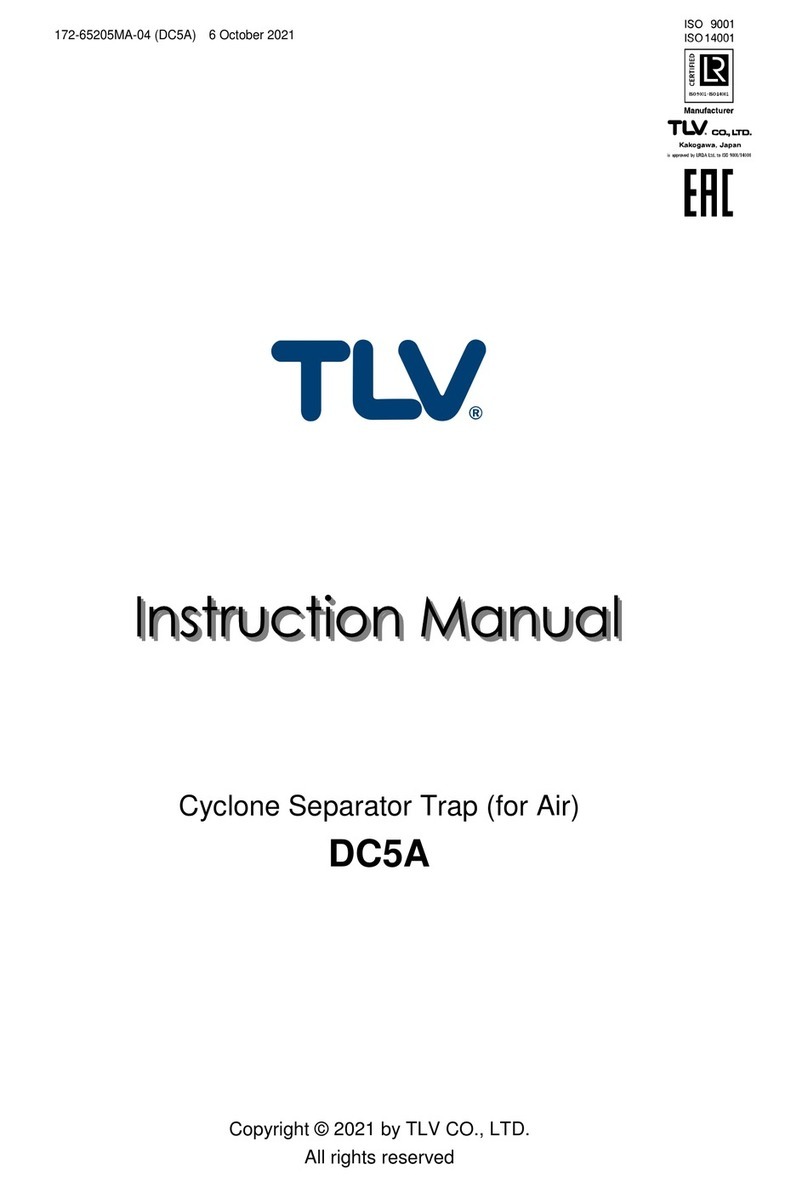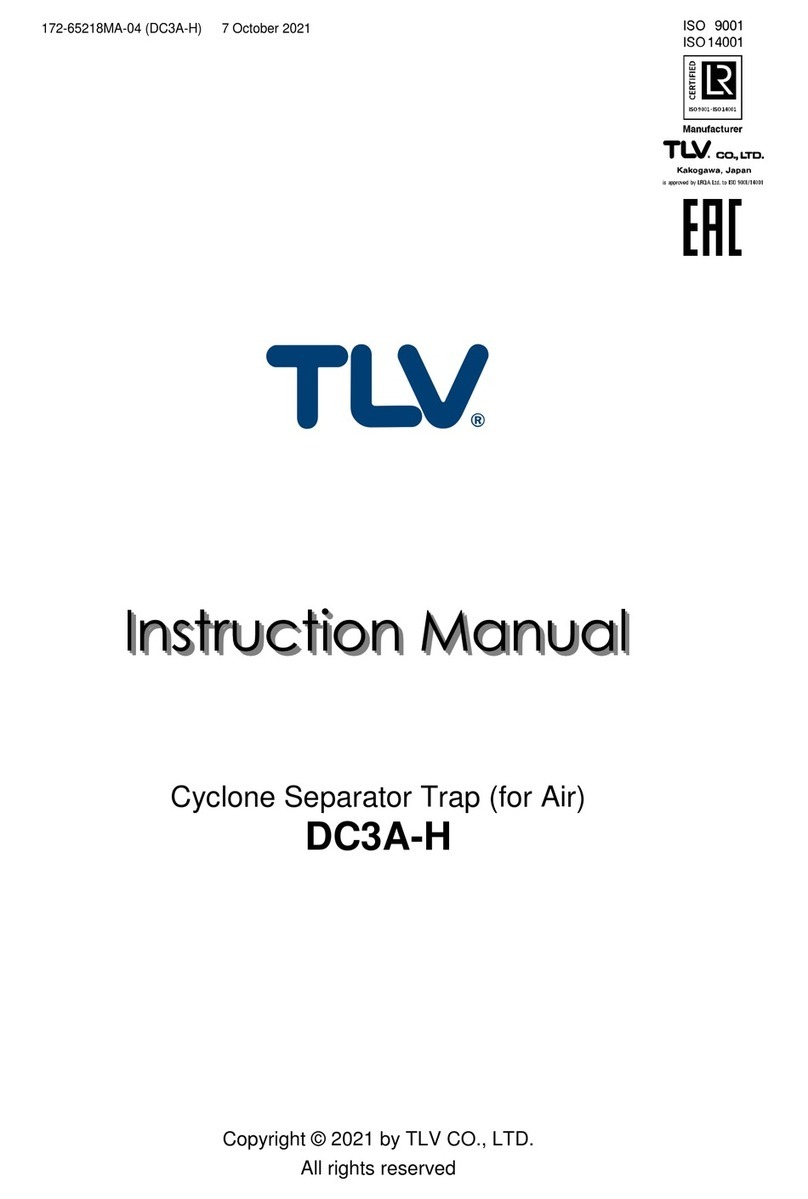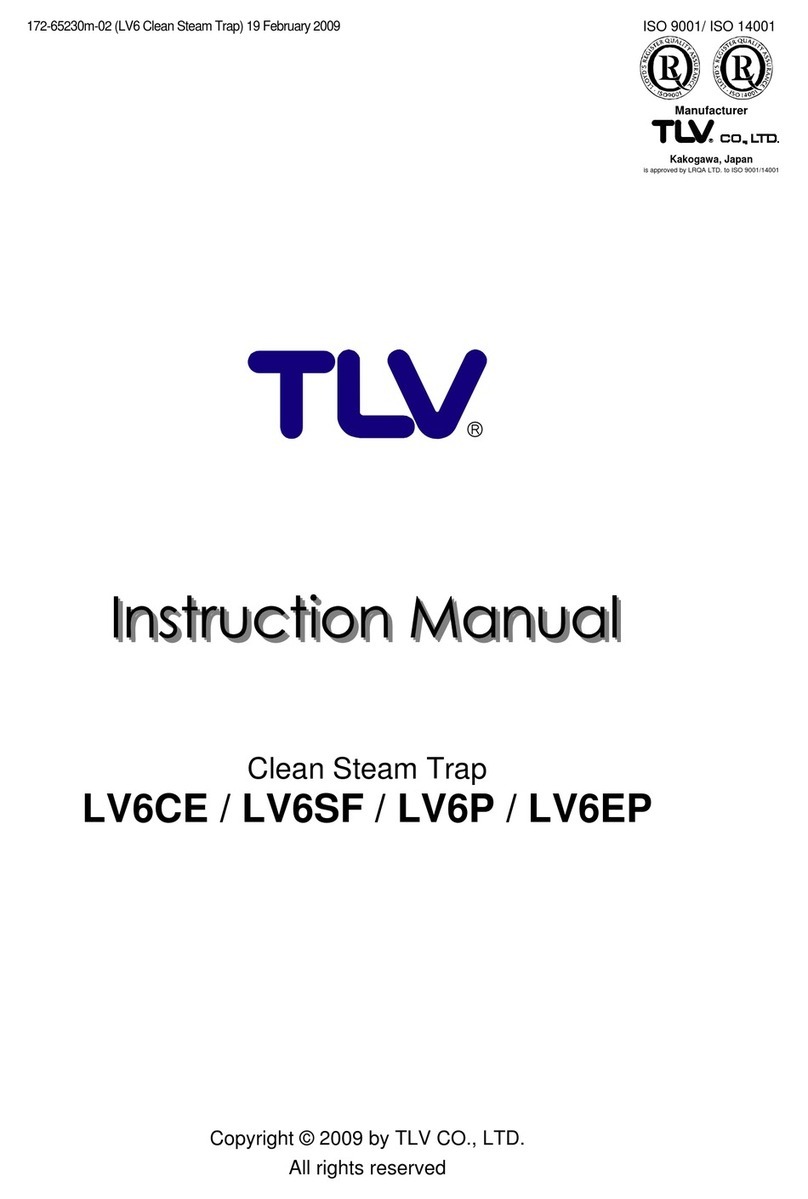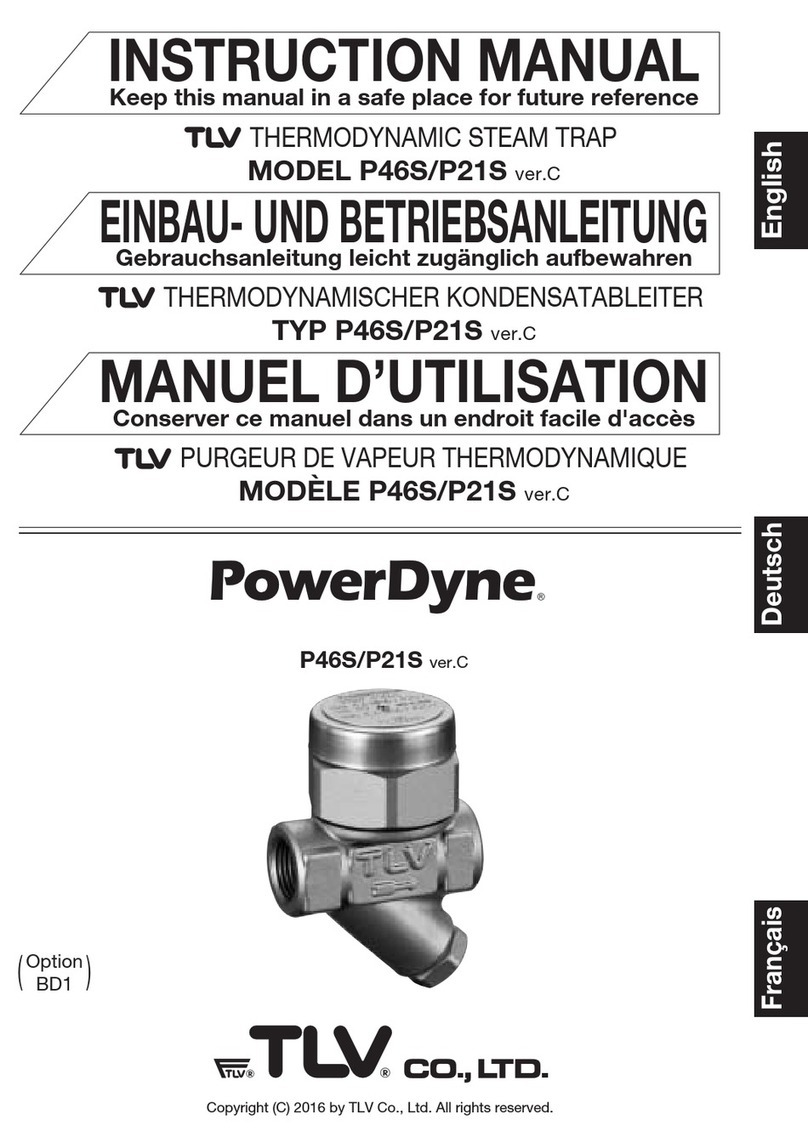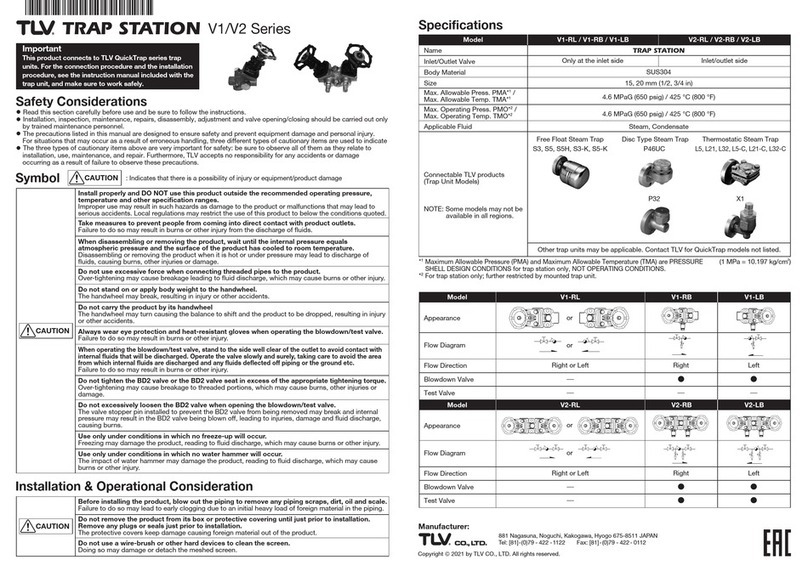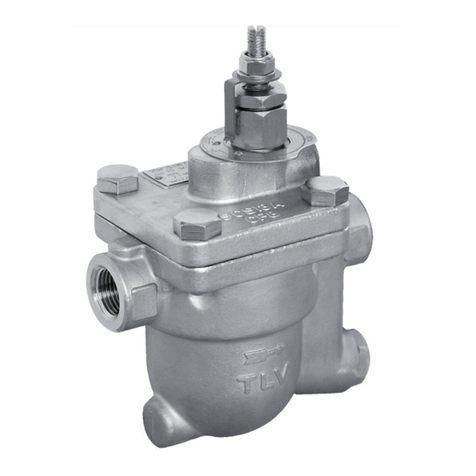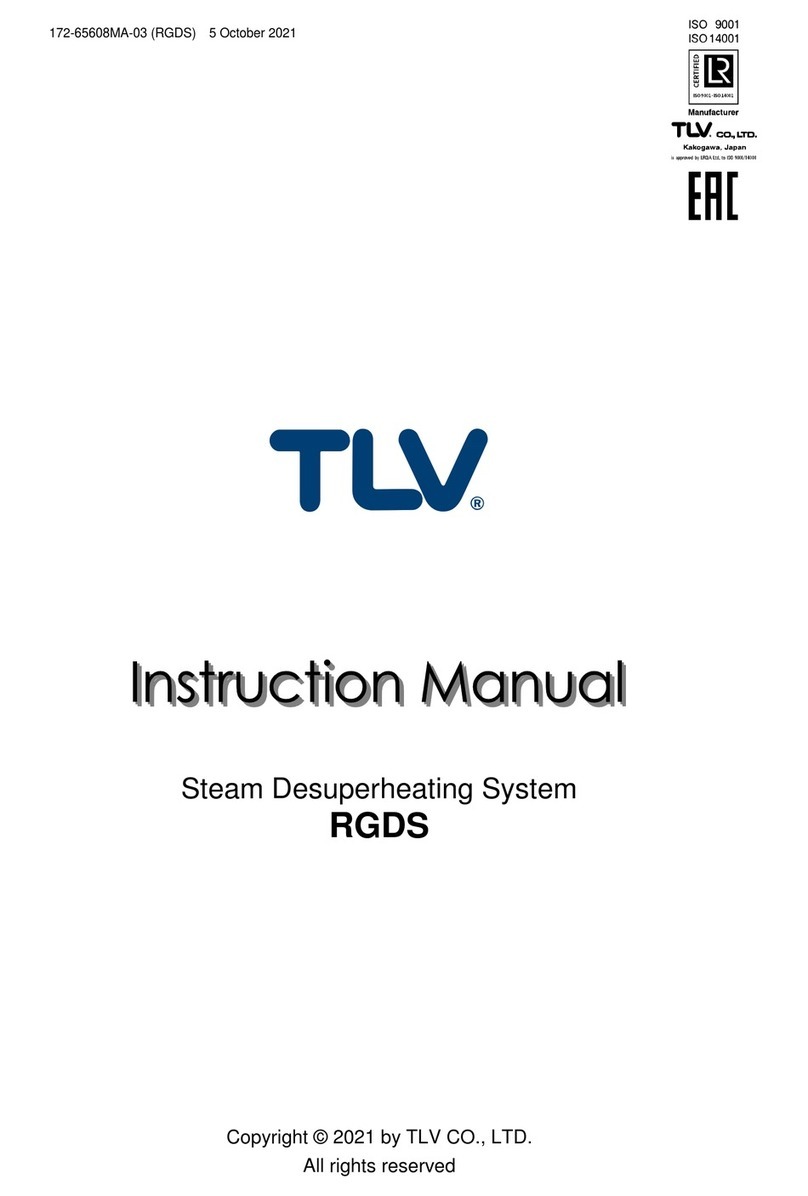TLV JH3LH-X User manual

Instruction Manual
Free Float Steam Trap with X-element
Model: JH3LH-X
172-65775M-00
Publication date 18 April 2023
Copyright © 2023 TLV CO., LTD.

Table of Contents
Introduction ............................................................................................................................... 3
Safety Considerations .............................................................................................................. 4
Checking the Piping .................................................................................................................. 6
Operation .................................................................................................................................. 7
Specifications ........................................................................................................................... 9
Configuration .......................................................................................................................... 10
Installation .............................................................................................................................. 11
Maintenance ........................................................................................................................... 12
Disassembly/Reassembly ...................................................................................................... 14
Instructions for Plug/Holder Disassembly and Reassembly ................................................... 18
Troubleshooting ...................................................................................................................... 19
TLV EXPRESS LIMITED WARRANTY ................................................................................... 20
Service ................................................................................................................................... 22
Options ................................................................................................................................... 23
2

Introduction
Thank you for purchasing the TLV free float steam trap.
This product has been thoroughly inspected before being shipped from the factory. When
the product is delivered, before doing anything else, check the specifications and external
appearance to make sure nothing is out of the ordinary. Also be sure to read this manual
carefully before use and follow the instructions to be sure of using the product properly.
This free float steam trap is of a revolutionary design that employs a high-performance
X-element as an air vent. It is best suited for steam equipment use. The X-element is very
sensitive to changes in temperature, and responds with great accuracy, allowing for the quick
discharge of large quantities of initial air and cold condensate immediately after operation
start-up, reducing start-up times. It also reacts with great sensitivity to the inflow of large
quantities of condensate and hot air during operation, preventing air binding.
This steam trap, which combines the superior features of the X-element with the proven
performance record of the free float, increases heating efficiency and reduces manpower
requirements for maintenance and bypass blowdown.
If detailed instructions for special order specifications or options not contained in this manual
are required, please contact TLV for full details.
This instruction manual is intended for use with the model(s) listed on the front cover. It is
necessary not only for installation, but for subsequent maintenance, disassembly/reassembly
and troubleshooting. Please keep it in a safe place for future reference.
3

Safety Considerations
• Read this section carefully before use and be sure to follow the instructions.
• Installation, inspection, maintenance, repairs, disassembly, adjustment and valve opening/
closing should be carried out only by trained maintenance personnel.
• The precautions listed in this manual are designed to ensure safety and prevent equipment
damage and personal injury. For situations that may occur as a result of erroneous handling,
three different types of cautionary items are used to indicate the degree of urgency and the
scale of potential damage and danger: DANGER, WARNING and CAUTION.
• The three types of cautionary items above are very important for safety: be sure to observe
all of them as they relate to installation, use, maintenance and repair. Furthermore, TLV
accepts no responsibility for any accidents or damage occurring as a result of failure to
observe these precautions.
Cautionary items and definitions
Danger
Indicates an urgent situation which poses a threat of death or serious injury
Warning
Indicates that there is a potential threat of death or serious injury
Caution
Indicates that there is a possibility of injury or equipment/product damage
Safety Considerations for the Product
Warning
NEVER apply direct heat to the float. The float may explode due to increased internal pressure,
causing accidents leading to serious injury or damage to property and equipment.
Caution
Install properly and DO NOT use this product outside the recommended operating
pressure, temperature and other specification ranges. Improper use may result in such
hazards as damage to the product or malfunctions that may lead to serious accidents. Local
regulations may restrict the use of this product to below the conditions quoted.
Caution
DO NOT use this product in excess of the maximum operating pressure differential. Such
use could make discharge impossible (blocked).
Caution
Take measures to prevent people from coming into direct contact with product outlets.
Failure to do so may result in burns or other injury from the discharge of fluids.
Caution
When disassembling or removing the product, wait until the internal pressure equals
atmospheric pressure and the surface of the product has cooled to room temperature.
Disassembling or removing the product when it is hot or under pressure may lead to discharge of
fluids, causing burns, other injuries or damage.
4

Caution
Be sure to use only the recommended components when repairing the product, and NEVER
attempt to modify the product in any way. Failure to observe these precautions may result in
damage to the product and burns or other injury due to malfunction or the discharge of fluids.
Caution
Use only under conditions in which no freeze-up will occur. Freezing may damage the
product, leading to fluid discharge, which may cause burns or other injury.
Caution
Use only under conditions in which no water hammer will occur. The impact of water hammer
may damage the product, leading to fluid discharge, which may cause burns or other injury.
5

Checking the Piping
Caution
Use only under conditions in which no water hammer will occur. The impact of water hammer
may damage the product, leading to fluid discharge, which may cause burns or other injury.
Check to make sure that the pipes to be connected to the product have been installed
properly.
1. Is the pipe diameter suitable?
2. Is the piping where the product is to be installed horizontal?
3. Has sufficient space been secured for maintenance?
4. Have isolation valves been installed at the inlet and outlet? If the outlet is subject to back
pressure, has a check valve (TLV-CK) been installed?
5. Is the inlet pipe as short as possible, with as few bends as possible, and installed so the
liquid will flow naturally down into the product?
6. Has the piping work been done correctly, as shown in the figures below?
Requirement Correct Incorrect
Install catchpot with the proper
diameter.
Diameter is too small.
Make sure the flow of
condensate is not obstructed.
Diameter is too small and inlet
protrudes into pipe interior.
To prevent rust and scale
from flowing into the trap, the
inlet pipe should be connected
25 to 50 mm above the base of
the T‑pipe.
Rust and scale flow into the
trap with the condensate.
When installing on the blind
end, make sure the flow of
condensate is not obstructed.
Condensate collects in the
pipe.
6

Operation
Principles of air and condensate discharge:
1. Initial Air and Cold Condensate Discharge
At startup, before steam is supplied, the trap is cold so the X-element is contracted and
the air vent valve seat (A) is open. This allows for the rapid discharge of air through the air
vent valve (A) and cold condensate through the orifice (B), when steam is first supplied to
the system.
2. Condensate Discharge
After the discharge of initial air and cold condensate, the heat of the inflowing steam and
condensate causes the X-element to expand, closing the air vent valve (A). The rising
condensate level causes the float to rise due to buoyancy, opening the orifice (B) and
allowing condensate to be discharged.
3. Hot Air Discharge
Should hot air flow into the trap with the steam during normal operation, the temperature
of the X-element drops, causing it to momentarily contract and open the air vent valve
(A), which allows for the rapid discharge of the air. After the air is discharged and steam
contacts the X-element, the temperature will increase causing the air vent valve (A) to
close.
7

4. Closed Position
When the condensate flow rate decreases, the float falls as condensate is discharged,
closing off the orifice (B). A water seal is maintained at all times over the orifice (B) to
prevent steam loss.
Note
The high steam temperature causes the X-element to expand, keeping the air vent closed.
Air
Steam
Condensate
8

Specifications
Caution
Install properly and DO NOT use this product outside the recommended operating
pressure, temperature and other specification ranges. Improper use may result in such
hazards as damage to the product or malfunctions that may lead to serious accidents. Local
regulations may restrict the use of this product to below the conditions quoted.
DO NOT use this product in excess of the maximum operating pressure differential. Such
use could make discharge impossible (blocked).
Use only under conditions in which no freeze-up will occur. Freezing may damage the
product, leading to fluid discharge, which may cause burns or other injury.
Refer to the product nameplate for detailed specifications.
A Model E Maximum Operating Temperature (TMO)
B Nominal Diameter F Maximum Differential Pressure (PMX)
C Maximum AllowablePressure (PMA)01 G Production Lot No.
D Maximum AllowableTemperature (TMA) H Valve No.02
01Maximum allowable pressure (PMA) and maximum allowable temperature (TMA) are PRESSURE
SHELL DESIGN CONDITIONS, NOT OPERATING CONDITIONS.
02Valve No. is displayed for products with options. This item is omitted from the nameplate when there
are no options.
9

Configuration
No. Part Name M R F No. Part Name M R
1 Body 10 Nameplate
2 Cover 11 Float Cover ✓
3 Float ✓12 X-element Guide ✓
4 Orifice Plug 13 X-element ✓
5 Orifice Plug Gasket ✓ ✓ 14 Spring Clip ✓
6 Orifice ✓15 Air Vent Valve Seat ✓
7 Orifice Gasket ✓ ✓ 16 Connector
8 Screen ✓17 Cover Bolt
9 Cover Gasket ✓ ✓
Replacement parts are available only in the following kits: M = maintenance kit, R = repair kit,
F = float
10

Installation
Caution
Install properly and DO NOT use this product outside the recommended operating
pressure, temperature and other specification ranges. Improper use may result in such
hazards as damage to the product or malfunctions that may lead to serious accidents. Local
regulations may restrict the use of this product to below the conditions quoted.
Take measures to prevent people from coming into direct contact with product outlets.
Failure to do so may result in burns or other injury from the discharge of fluids.
Installation, inspection, maintenance, repairs, disassembly and adjustment and valve opening/
closing should be carried out only by trained maintenance personnel.
1. Before installation, be sure to remove all protective seals.
2. Before installing the product, blow out the inlet piping to remove any piping scraps, dirt and
oil. Close the inlet valve after blowdown.
3. Install the product so the arrow on the body is pointing in the direction of flow.
4. The product unit must be inclined no more than 5° horizontally and front-to-back.
5. Install a condensate outlet valve and outlet piping.
6. Open the inlet and outlet valves and ensure that the product functions properly.
If there is a problem, determine the cause using the "Troubleshooting" section in this manual.
Tolerance Angle for Installation: 5°
Make sure the product is installed with the raised TLV lettering on the body horizontal.
11

Maintenance
Caution
Take measures to prevent people from coming into direct contact with product outlets.
Failure to do so may result in burns or other injury from the discharge of fluids.
Be sure to use only the recommended components when repairing the product, and NEVER
attempt to modify the product in any way. Failure to observe these precautions may result in
damage to the product and burns or other injury due to malfunction or the discharge of fluids.
Operational Check
A visual inspection of the following items should be done on a daily basis to determine
whether the product is operating properly or has failed. Periodically (at least biannually) the
operation should also be checked by using diagnostic equipment such as a stethoscope,
thermometer, TLV Pocket TrapMan or TLV TrapMan.
If the product should fail, it may cause damage to piping and equipment, resulting in faulty or
low quality products or losses due to steam leakage.
Normal: Condensate is discharged continuously, together with flash steam, and the
sound of flow can be heard. If there is very little condensate, there is almost
no sound of flow.
Blocked
(Discharge
Impossible):
No condensate is discharged. The product is quiet and makes no noise, and the
surface temperature of the product is low.
Blowing: Live steam continually flows from the outlet and there is a continuous metallic
sound.
Steam Leakage: Live steam is discharged through the product outlet together with condensate,
accompanied by a high-pitched sound.
(When conducting a visual inspection, flash steam is sometimes mistaken for steam leakage.
For this reason, the use of a steam trap diagnostic instrument such as TLV TrapMan in
conjunction with the visual inspection is highly recommended.)
Flash Steam Live Steam Leakage
White jet containing water droplets Clear, slightly bluish jet
12

Parts Inspection
When parts have been removed, or during periodic inspections, use the following table to
inspect the parts and replace any that are found to be defective.
Gaskets: Check for warping or scratches
Screen: Check for clogging or corrosion
X-element: Check for scratches
Air Vent Valve Seat: Check for scratches
Float: Check for scratches or dents
Body Interior: Check for build-up
After cleaning the inside of the body:
Gaskets: Check for warping or scratches
Orifice Opening: Check for dirt, oil film, wear or scratches
13

Disassembly/Reassembly
Warning
NEVER apply direct heat to the float. The float may explode due to increased internal pressure,
causing accidents leading to serious injury or damage to property and equipment.
Caution
When disassembling or removing the product, wait until the internal pressure equals
atmospheric pressure and the surface of the product has cooled to room temperature.
Disassembling or removing the product when it is hot or under pressure may lead to discharge of
fluids, causing burns, other injuries or damage.
Use the following procedures to remove components. Use the same procedures in reverse to
reassemble.
(Installation, inspection, maintenance, repairs, disassembly, adjustment and valve opening/
closing should be carried out only by trained maintenance personnel.)
Drain Plug (Option)
Part Name During Disassembly During Reassembly
Drain Plug Remove with a socket wrench Consult the table of tightening torques
and tighten to the proper torque
Drain Plug
Gasket Remove the gasket and clean sealing
surfaces Replace with a new gasket
Detaching/Reattaching the Cover
Part Name & No. During Disassembly During Reassembly
Cover Bolt 17 Remove with a socket wrench Consult the table of tightening torques
and tighten to the proper torque
Cover 2 Remove by lifting up and off Make sure there are no pieces of
the old gasket left on the sealing
surfaces of the body and cover, align
the cover with the body and connector
and reattach
Connector 16 Remove the connector Reinsert it into the hole in the body
Cover Gasket 9 Remove the gasket and clean sealing
surfaces Replace with a new gasket if
misshapen or damaged
14

Disassembly/Reassembly of Components Inside the Cover
Part Name & No. During Disassembly During Reassembly
Spring Clip 14 Pinch the insides together and remove
from the X-element guide Insert securely into the groove in the
guide
X-element 13 Remove from the X-element guide Insert after making sure of the correct
orientation
Air Vent Valve
Seat 15 Remove with a socket wrench Consult the table of tightening torques
and tighten to the proper torque
X-element Guide
12 Remove without bending Fix with the air vent valve seat and
make sure the X-element can be
inserted smoothly
Disassembly/Reassembly of Components Inside the Body
Part Name & No. During Disassembly During Reassembly
Float Cover 11
Screen 8 Lift straight up and out while rocking
slowly Align the arrows on the float cover (a)/
screen and the body, insert with the
tab (b) on the bottom fitting into the
slot in the body; make sure the screen
does not stick out of the body
Float 3 Remove, being careful not to scratch
the polished surface Insert, being careful not to scratch the
polished surface
Orifice Plug 4 Remove with a socket wrench Consult the table of tightening torques
and tighten to the proper torque
Orifice Plug
Gasket 5 Remove the gasket and clean sealing
surfaces Replace with a new gasket; coat
surfaces with anti-seize
Orifice 6 Remove with a socket wrench Consult the table of tightening torques
and tighten to the proper torque
Orifice Gasket 7 Remove the gasket and clean sealing
surfaces Replace with a new gasket; coat
surfaces with anti-seize
15

Table of Tightening Torques
Part Name & No. Torque
N·m Distance Across Flats
mm
Cover Bolt 17 50 18
Air Vent Valve Seat 15 35 19
Orifice Plug 4 80 24
Orifice 6 30 10
Note
• Coat all threaded portions with anti-seize.
• If drawings or other special documentation were supplied for the product, any torque given there
takes precedence over values shown here.
16

Exploded View
No. Part Name No. Part Name
1 Body 10 Nameplate
2 Cover 11 Float Cover
3 Float 12 X-element Guide
4 Orifice Plug 13 X-element
5 Orifice Plug Gasket 14 Spring Clip
6 Orifice 15 Air Vent Valve Seat
7 Orifice Gasket 16 Connector
8 Screen 17 Cover Bolt
9 Cover Gasket
17

Instructions for Plug/Holder Disassembly and
Reassembly
The seal on the threaded plugs/holders found on TLV products is formed by a flat metal
gasket. There are various installation orientations for the gaskets, such as horizontal, diagonal
and downward, and the gasket may be pinched in the thread recesses during assembly.
Instructions for Disassembly and Reassembly
1. Remove the plug/holder using a tool of the specified size (distance across flats).
2. The gasket should not be reused. Be sure to replace it with a new gasket.
3. Clean the gasket surfaces of the plug/holder and the product body using a rag and/or
cleaning agents, then check to make sure the surfaces are not scratched or deformed.
4. Coat both the gasket surface of the plug/holder and the threads of the plug/holder with
anti-seize, then press the gasket onto the center of the gasket surface of the plug/holder,
making sure the anti-seize affixes the gasket tightly to the plug/holder. Check to make sure
the gasket is not caught in the recesses of the threads.
5. Hold the plug/holder upside down to make sure that the anti-seize makes the gasket stick
to the plug/holder even when the plug/holder is held upside down.
6. Screw the plug/holder by hand into the product body while making sure that the gasket
remains tightly affixed to the center of the gasket surface of the plug/holder. Make sure
the entire gasket is making contact with the gasket surface of the product body. It is
important at this point to make sure the gasket is not pinched in the thread recesses of the
plug/holder.
7. Tighten the plug/holder to the proper torque.
8. Next, begin the supply of steam and check to make sure there is no leakage from the
part just tightened. If there is leakage, immediately close the inlet valve and, if there is a
bypass valve, take the necessary steps to release any residual pressure. After the surface
of the product cools to room temperature, repeat the procedure beginning from step 1.
18

Troubleshooting
Warning
NEVER apply direct heat to the float. The float may explode due to increased internal pressure,
causing accidents leading to serious injury or damage to property and equipment.
Caution
When disassembling or removing the product, wait until the internal pressure equals
atmospheric pressure and the surface of the product has cooled to room temperature.
Disassembling or removing the product when it is hot or under pressure may lead to discharge of
fluids, causing burns, other injuries or damage.
If the product fails to operate properly, use the following table to locate the cause and remedy.
Problem Cause Remedy
No condensate
is discharged
(blocked) or
discharge is poor
The float is damaged or filled with
condensate Replace with a new float
The orifice opening, screen or piping
are clogged with rust and scale Clean parts
The X-element is scratched or
damaged Replace with a new X-element
The product operating pressure
exceeds the maximum specified
pressure, or there is insufficient
pressure differential between the
product inlet and outlet
Compare specifications and actual
operating conditions
Steam locking has occurred Perform a bypass blowdown or close
the trap inlet valve and allow the
product to cool
Steam is
discharged or
leaks from the
outlet
(blowing)
(steam leakage)
Clogged orifice opening or rust and
scale build-up beneath the float Clean parts
Scratches on the orifice Replace with a new orifice
The float is misshapen or has surface
build-up Clean or replace with a new float
Improper installation orientation Correct the installation
Trap vibration Lengthen the inlet piping and fasten it
securely
The X-element air vent valve seating
and/or air vent valve seat have surface
build-up or are scratched
Clean or replace with a new X-
element/air vent valve seat
Steam is leaking
from a place other
than the outlet
Gasket deterioration or damage Replace with new gasket(s)
Improper tightening torques were used Tighten to the proper torque
Float frequently
becomes
damaged
Water hammer has occurred Study and correct the piping
Note
When replacing parts with new, use the parts list for reference, and replace with parts from the
Maintenance kit, Repair kit, etc. Please note that replacement parts are only available as part of a
replacement parts kit.
19

TLV EXPRESS LIMITED WARRANTY
Subject to the limitations set forth below, TLV CO., LTD., a Japanese corporation (“TLV”),
warrants that products which are sold by it, TLV International Inc. (“TII”) or one of its
group companies excluding TLV Corporation (a corporation of the United States of America),
(hereinafter the “Products”) are designed and manufactured by TLV, conform to the
specifications published by TLV for the corresponding part numbers (the “Specifications”)
and are free from defective workmanship and materials. The party from whom the Products
were purchased shall be known hereinafter as the “Seller”. With regard to products or
components manufactured by unrelated third parties (the “Components”), TLV provides no
warranty other than the warranty from the third party manufacturer(s), if any.
Exceptions to Warranty
This warranty does not cover defects or failures caused by:
1. improper shipping, installation, use, handling, etc., by persons other than TLV, TII or TLV
group company personnel, or service representatives authorized by TLV; or
2. dirt, scale or rust, etc.; or
3. improper disassembly and reassembly, or inadequate inspection and maintenance by
persons other than TLV or TLV group company personnel, or service representatives
authorized by TLV; or
4. disasters or forces of nature or Acts of God; or
5. abuse, abnormal use, accidents or any other cause beyond the control of TLV, TII or TLV
group companies; or
6. improper storage, maintenance or repair; or
7. operation of the Products not in accordance with instructions issued with the Products or
with accepted industry practices; or
8. use for a purpose or in a manner for which the Products were not intended; or
9. use of the Products in a manner inconsistent with the Specifications; or
10. use of the Products with Hazardous Fluids (fluids other than steam, air, water, nitrogen,
carbon dioxide and inert gases (helium, neon, argon, krypton, xenon and radon)); or
11. failure to follow the instructions contained in the TLV Instruction Manual for the Product.
Duration of Warranty
This warranty is effective for a period of one (1) year after delivery of Products to the first end
user. Notwithstanding the foregoing, asserting a claim under this warranty must be brought
within three (3) years after the date of delivery to the initial buyer if not sold initially to the first
end user.
ANY IMPLIED WARRANTIES NOT NEGATED HEREBY WHICH MAY ARISE BY
OPERATION OF LAW, INCLUDING THE IMPLIED WARRANTIES OF MERCHANTABILITY
AND FITNESS FOR A PARTICULAR PURPOSE AND ANY EXPRESS WARRANTIES NOT
NEGATED HEREBY, ARE GIVEN SOLELY TO THE INITIAL BUYER AND ARE LIMITED IN
DURATION TO ONE (1) YEAR FROM THE DATE OF SHIPMENT BY THE SELLER.
Exclusive Remedy
THE EXCLUSIVE REMEDY UNDER THIS WARRANTY, UNDER ANY EXPRESS
WARRANTY OR UNDER ANY IMPLIED WARRANTIES NOT NEGATED HEREBY
(INCLUDING THE IMPLIED WARRANTIES OF MERCHANTABILITY AND FITNESS FOR A
PARTICULAR PURPOSE), IS REPLACEMENT; PROVIDED: (a) THE CLAIMED DEFECT IS
20
Table of contents
Other TLV Industrial Equipment manuals
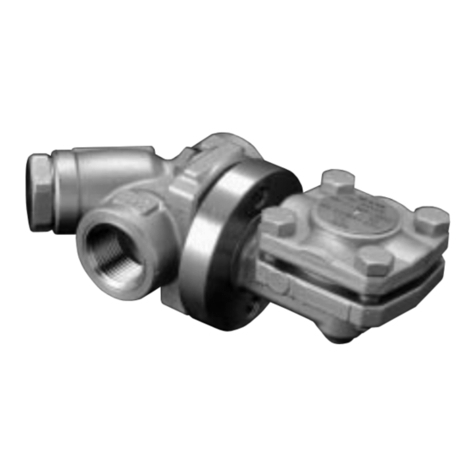
TLV
TLV QuickTrap FL Series User manual
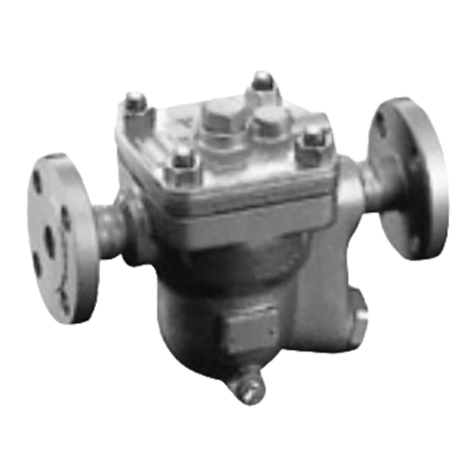
TLV
TLV JH-X Series User manual

TLV
TLV PowerDyne QuickTrap P46UC-Y User manual
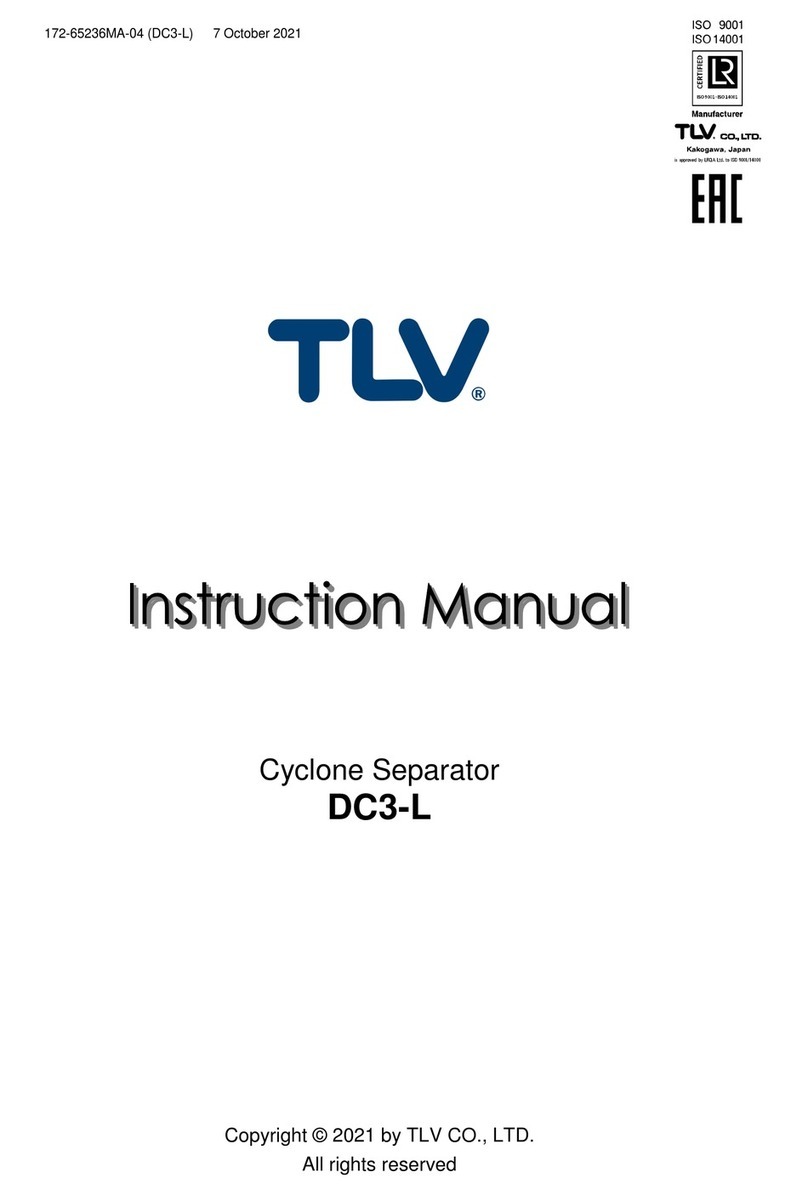
TLV
TLV DC3-L User manual
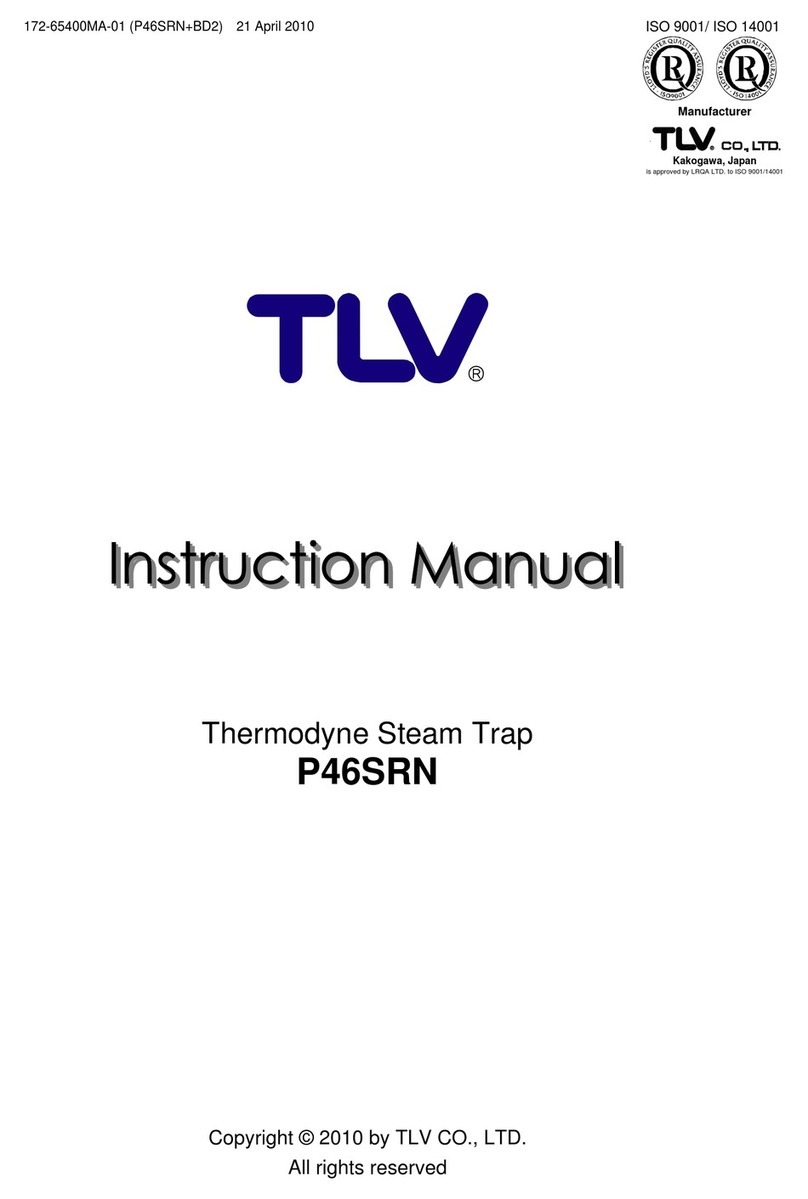
TLV
TLV PowerDyne P46SRN User manual

TLV
TLV PowerDyne P21S User manual

TLV
TLV SW1U-A User manual

TLV
TLV QuickTrap FP32 User manual
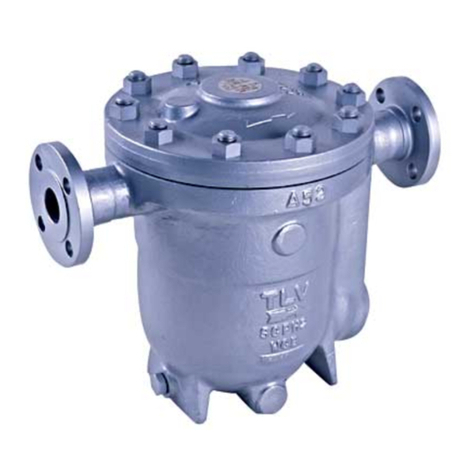
TLV
TLV JH7.5R-P User manual
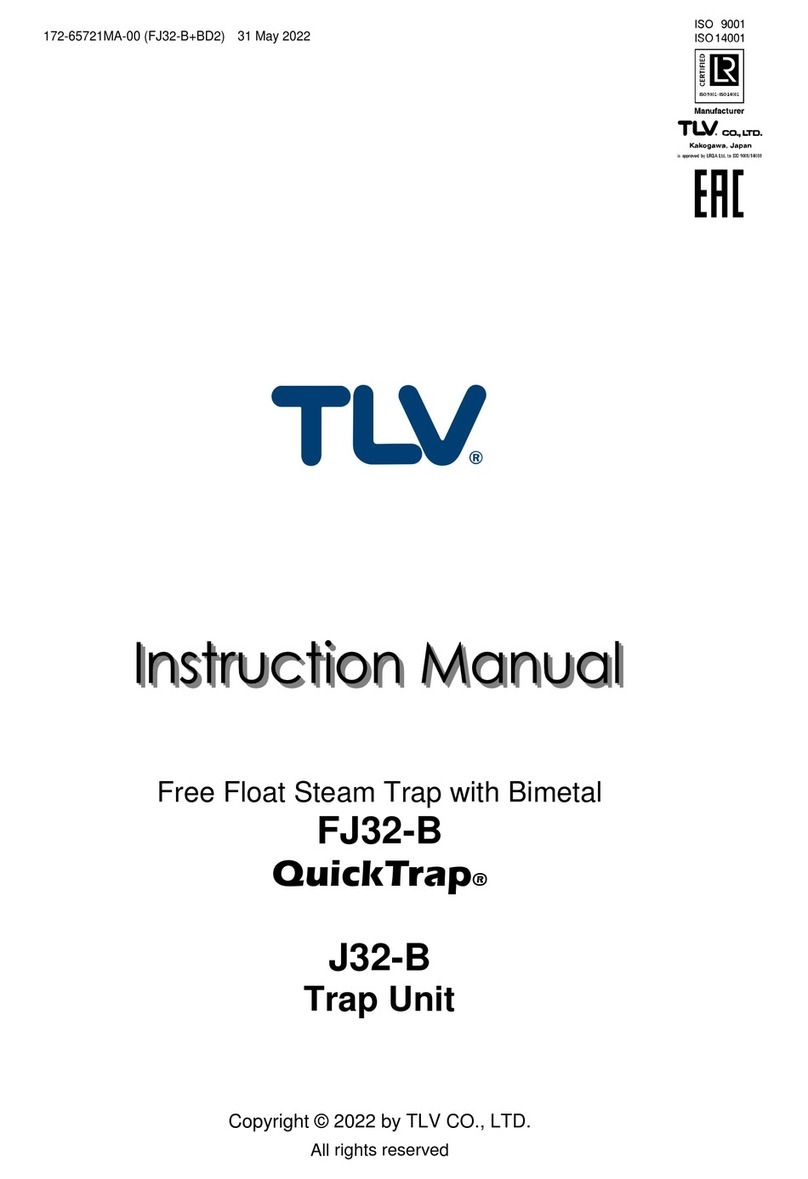
TLV
TLV QuickTrap FJ32-B User manual

